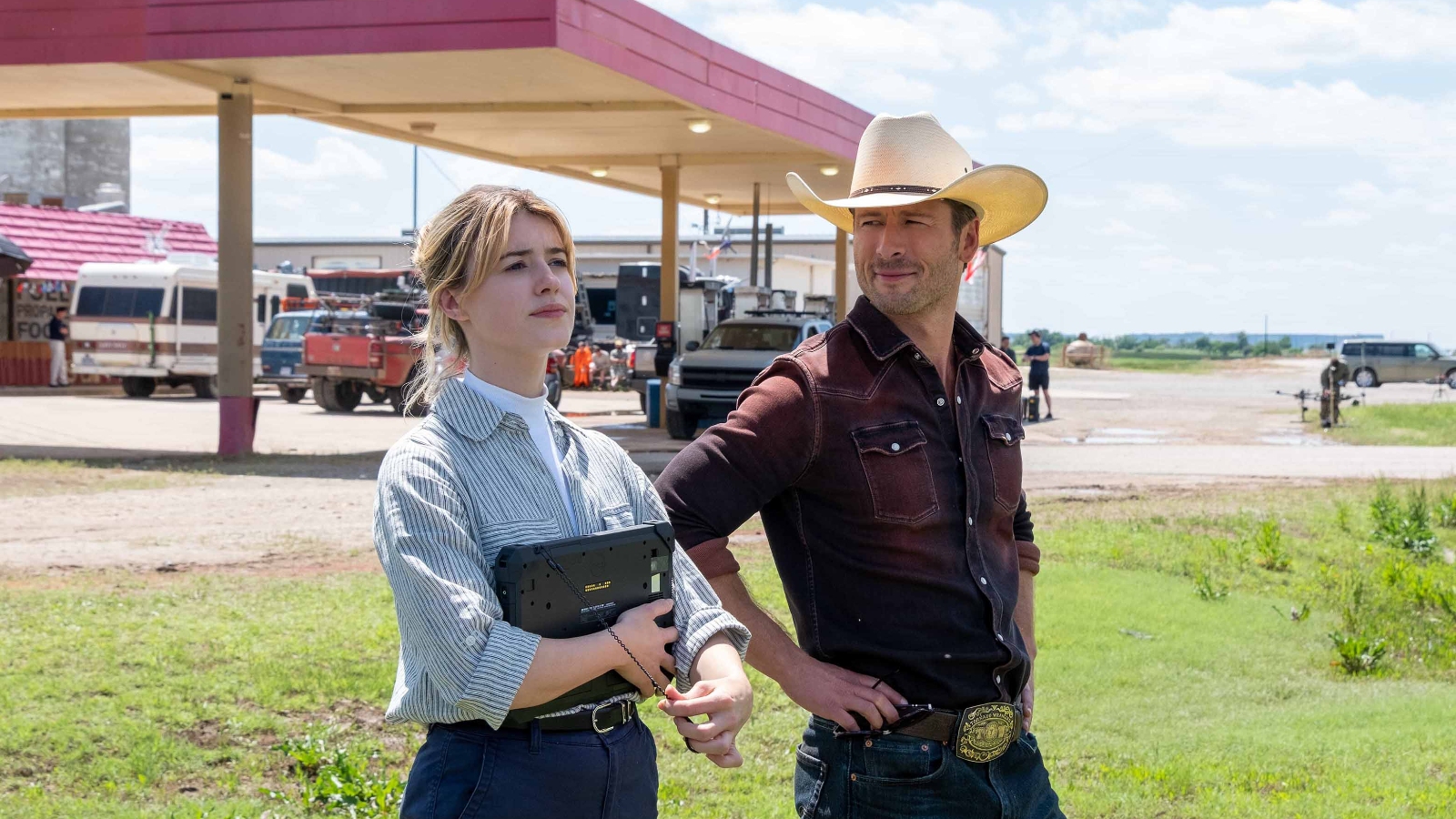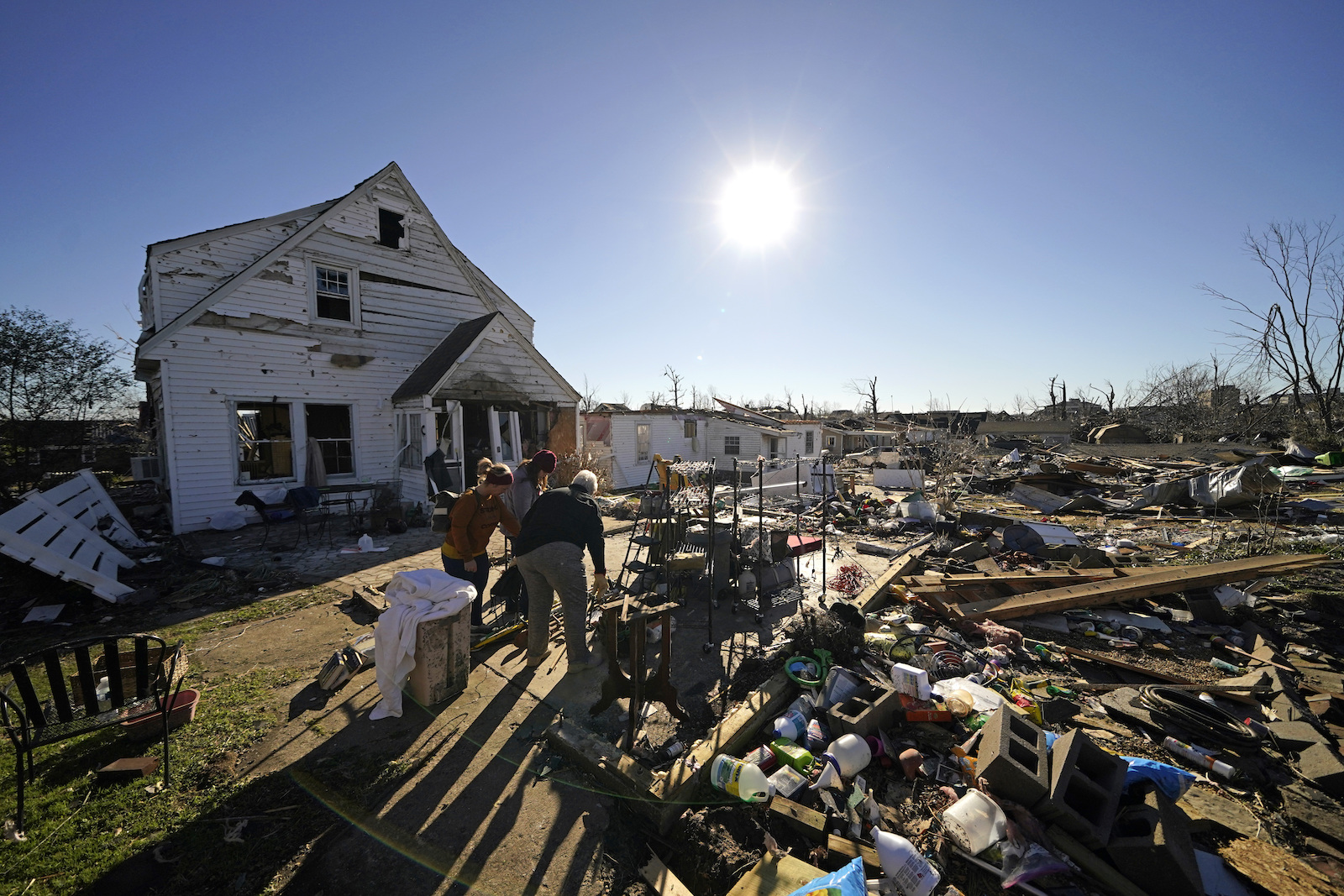The words “climate change” make no appearance whatsoever in the new film Twisters. This makes political sense: For a blockbuster designed to maximize the broad appeal of its computer-generated thrills, a direct climate tie-in might have been box-office poison. Nevertheless, this summer’s reboot of the classic 1996 thriller of (nearly) the same name tackles a central dilemma of our disaster-prone era. Storms fueled by global warming claim thousands of lives and destroy billions of dollars in property every year, but we can’t quite agree on the right way to direct society’s resources to responding to this fact. When it comes to climate-fueled disasters, should we pledge our chips to scientific research, state-of-the-art engineering or just moving ourselves out of harm’s way?
In spite of the film’s own best efforts to keep things light, Twisters manages to elevate this dilemma in a somewhat provocative way. The film is not an ordinary, Day After Tomorrow-style fable about the awesome power of nature, but instead a parable about the ethics of climate adaptation, one that dramatizes the ways that scientists, engineers, and profiteers respond to nature’s power. But while the film deserves some credit for broaching the question of what a just and effective disaster response would look like, the way it actually answers this question is about as flat as the Tornado Alley plains in which it takes place.
The protagonist of the film is Kate Carter (Daisy Edgar-Jones), an Oklahoma-born meteorologist with a tornado obsession and an oddly intermittent Southern accent. Kate has a special gift for predicting the weather, demonstrated in the film by the fact that she looks at the sky rather than a computer to figure out if it’s going to rain. As a bright-eyed graduate student, she dreams of developing a chemical solution that could weaken tornadoes before they destroy homes. However — and the spoilers begin here — Kate’s rash attempt to test the idea on a monster storm gets three of her fellow scientists killed.
The bulk of the film takes place five years later when, chastened, Kate is working a boring desk job at the National Weather Service in New York. Out of the blue, her only surviving comrade approaches to ask for help with one last job. Javi (Anthony Ramos) has developed a technology that provides high-resolution scans of tornado dynamics — but only if he can find a way to deploy it just a few feet from an emerging tornado. Javi lures Kate back out to Oklahoma to help his new startup, Storm Par, track down tornadoes so it can deploy the tech and grab the data. When he makes his pitch to Kate, Javi seems to invoke the mounting toll of climate change: “It’s getting worse every year, but now we have a way to fight back.”
Indeed, it is getting worse every year in the real world, too. Annual property losses from tornadoes and other convective storms have risen around 8 percent each year since 2008, according to the reinsurance company Swiss Re, rattling the insurance industry and leading to huge premium price increases in states like Oklahoma. Residents of the Sooner State pay the highest average homeowner’s insurance premium of any state in the United States — higher even than hurricane-prone Florida — a trend driven primarily by tornado and hail claims.
Even so, the science linking climate change and tornadoes is somewhat less certain than Javi implies. On the one hand, warmer air is less stable and holds more moisture, so there’s reason to believe that a hotter world will feature more of the convective storms that spin off tornadoes. However, the twisters themselves are so fleeting and ephemeral that it’s hard to know for sure. There is also some evidence that the geographic extent of Tornado Alley has shifted south and east into states such as Alabama, away from the Oklahoma heartland where the film takes place. And insurers argue that it’s mostly increasing population density and inflation in building material costs that are driving the insurance crisis, rather than climatic shifts.
Either way, Javi is right that something’s got to give, and Kate heeds the call. When they arrive in Oklahoma during an epic tornado outbreak, they find they have competition from Tyler Owens (Glen Powell), a hotshot YouTuber who has racked up millions of fans by driving a souped-up Dodge Ram straight into the heart of tornadoes. (This gas-guzzling product placement may be the least climate-friendly part of the film.) Tyler soon develops a romantic interest in Kate, which he demonstrates by showing up wherever she goes five minutes later and smirking at her. It seems like a serviceable enough setup: A cute-but-nerdy scientist chases storms for the sake of science and public welfare, while an influencer chases them for clout and personal gain — but there’s a magnetism between them nonetheless.
Except it’s not that simple. It turns out that Storm Par’s lead investor is a real estate developer named Marshall Riggs. Riggs knows that many Oklahomans are underinsured and can’t afford to rebuild after tornadoes, and he wants to scoop up their houses with cash offers so he can develop new subdivisions. Javi started the company to collect data that could protect people from tornadoes, but now he’s doing the bidding of someone who wants to, as one character perhaps a bit clumsily puts it, “profit off of people’s tragedy.” (Why Riggs needs advanced meteorological data to make cash offers on destroyed homes is unclear, and perhaps was never clear to the screenwriters.)
Here, too, the film gets something right in the abstract. It really is common for real estate speculators to descend on areas that have experienced a devastating disaster, like Maui after last year’s Lahaina fire, and make aggressive all-cash offers for homes. Many fire, flood, and tornado victims lack the kind of insurance coverage that can pay for a full rebuild of their properties, which makes these low-ball offers very difficult to turn down, especially for those with modest incomes. In the aftermath of Hurricane Harvey in 2017, for instance, hedge funds such as Cerberus Capital Management purchased hundreds of flooded homes at a discount and flipped them as rental houses, easily clawing back their initial investments.
While Kate discovers the more unseemly side of Javi’s business venture, she simultaneously discovers that the hotshot storm chaser Tyler is also more complicated than he seems. Kate dismisses his antics at first (he shoots fireworks into tornadoes and sells T-shirts with his face on them), but she softens up once she sees him and his team giving out free food and supplies to tornado victims. Out of all the people gathered to chase tornadoes, Tyler and his gang are the only ones who are actually helping. Even Kate the do-gooder scientist finds she hasn’t actually done much good — after all, she got her original team killed because she was too thirsty for an academic grant, or so Javi implies during one tense exchange. If you aren’t funneling resources to those who live in the shadow of these storms, what’s the point?
Ham-handed though this plot twist might be, it too tracks a real-world ethical dilemma. Journalists spend their readers’ money to illuminate the stories of disaster victims, and scientists take money from governments and universities to study these storms — but wouldn’t it be better just to give that money to the victims? As if to hammer the point home, the disaster response agency FEMA is conspicuously absent in the film’s portrayal of Oklahoma: Perhaps the agency’s primary disaster relief fund has run out of money in the film, as in reality it almost did last year and may well do this year.
This dilemma raises a further question: If money is best spent reducing suffering, wouldn’t it be better to reduce vulnerability to disasters in the first place rather than just cleaning up after they hit? Twisters pursues this question to a point, but it opts for an easy answer, taking refuge in a fantasy that humans can engineer their way out of disasters without changing anything about the way they build, consume, and live.
After learning the truth about Storm Par’s business model, Kate has a moment of moral reckoning, represented in predictable fashion by a tearful nighttime drive with a Lainey Wilson ballad playing in the background. Desperate to help storm victims, she revives her old idea of a chemical solution that can slow down tornadoes, using newfangled data to perfect the concept. Interestingly, the new film’s endorsement of this brash techno-optimism is an update to the original Twister, in which Helen Hunt’s intrepid scientist tries to design a tool that can collect data to predict tornadoes, rather than destroy them. In the 30 years between the original movie and its reboot, in other words, we’ve graduated from measuring nature to controlling it, an apparent recognition that today’s storms are too dangerous to leave untouched.
It’s worth pausing for a moment to evaluate just how useful Kate’s contraption would really be. It can disintegrate tornadoes, sure, but you have to drive it into a tornado to do it, and the whole problem with tornadoes is that they can appear almost anywhere in a matter of minutes. If millions of homes, stores, and schools are vulnerable to destruction by these disasters, as in fact they are, is a miracle gizmo really the best solution? Probably not any more than cloud seeding is the best solution for a millennium-scale drought, or a multibillion-dollar system of interlocking flood gates is the best solution for sea level rise.
It’s clear that at least a few people involved with the making of the film intended Kate’s quest to serve as an allegory for climate adaptation in general. Coded references to climate change are everywhere: An early tornado kickstarts some wind turbines, then knocks them over. The climactic twister rolls through an oil refinery and sends a pumpjack hurtling into the water tower, which collapses and almost smashes Glen Powell’s already oddly shaped head. Kate’s mother, a farmer, notes that there seem to be “more tornadoes, and floods, and droughts,” and mourns the climate-related inflation that causes swings in the price of commodity wheat.
By the same token, Kate’s chemical solution could be seen as a stand-in for human ingenuity intended to confront climate disasters. But the big problem with tornadoes, as with the other disasters enumerated by Kate’s mother, is not that we don’t have tools that can blast them into oblivion. Rather, it’s the insight that Javi has as he and the residents of the idyllic town of New Reno cower in the town’s elegant movie theater while the film’s climactic twister approaches.
“This theater isn’t built to withstand what’s coming!” yells Javi, pushing the townspeople away from a collapsing wall.
Indeed.





